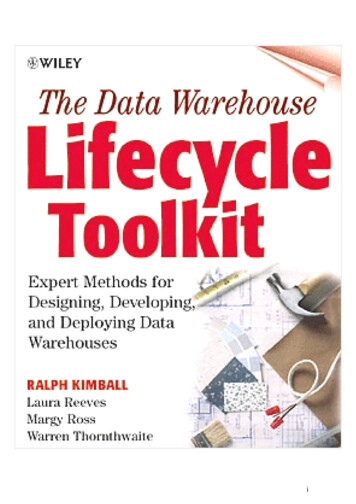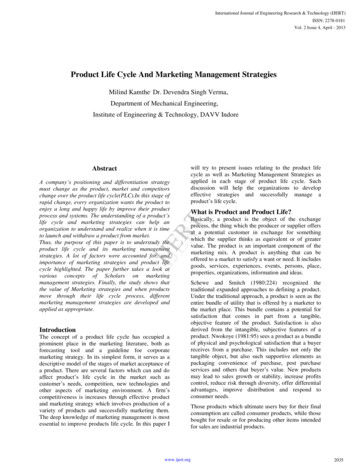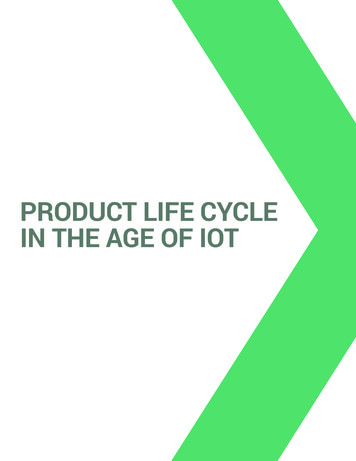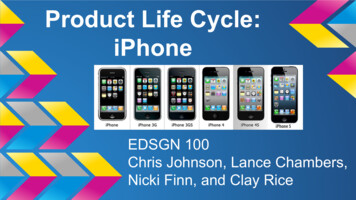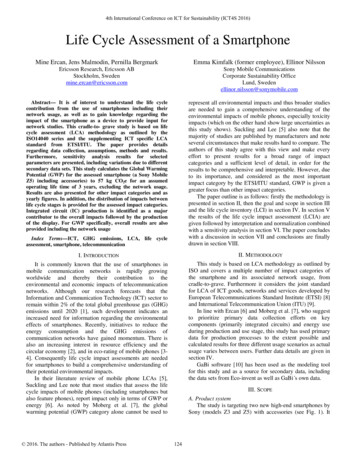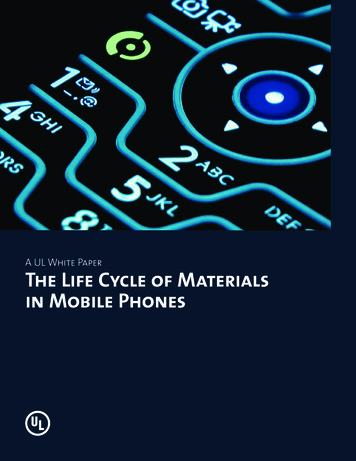
Transcription
A UL White PaperThe Life Cycle of Materialsin Mobile Phones
The Life Cycle of Materials in Mobile PhonesHow New Phone Technology Affects the EnvironmentIn just 30 years, mobile telephony has grown into a major global industry, with anestimated 5 billion users around the world (compared with a total world populationof just under 7 billion people). While new subscriber growth has slowed somewhatin recent years, product turnover remains high, with over 1 billion new mobilephones shipped in 2009 alone. As a result of ever-advancing technology and productobsolescence in this market, it is estimated that some 300,000 mobile phones are sentto the trash every day in the United States alone.This white paper examines the overall environmental impact of materials used inmobile phones, from the extraction of raw materials and component manufacturingrequired to produce the latest models, to the appropriate recovery and recycling ofthese products at end-of-life (EoL). While the scope of this paper is limited to mobilephones, similar materials are used in many other high technology products, includingpersonal computers, portable entertainment players, and other types of informationand communications devices. Energy consumption and radio frequency emissions at theproduct level are outside the scope of this paper.Regulated Substances andWaste LegislationThe European Commission (EC) is amongthe most active and aggressive regulatorsseeking to address the environmentalimpact of electrical and electronicequipment. Increasing concerns regardingthe toxicity of several heavy metalsand flame retardants used in electronicThe EU’s RoHS Directive regulatesspecific hazardous substances, withconcentrations limited in parts permillion (ppm) by the weight of eachhomogeneous material that can bemechanically separated, as follows: Cadmium (Cd) — 0.01% (100 ppm) Lead (Pb) — 0.1% (1000 ppm)equipment led to the Commission’s Mercury (Hg) — 0.1% (1000 ppm)directive on the restriction of the use of Hexavalent chromium (Cr(VI))certain hazardous substances in electricaland electronic equipment (2002/95/EC,also known as the RoHS Directive), whichcame into force in European Union (EU)member states in July 2006.— 0.1% (1000 ppm) Polybrominated diphenyls (PBB)— 0.1% (1000 ppm) Polybrominated diphenyl ethers (PBDE)— 0.1% (1000 ppm)page 2
The Life Cycle of Materials in Mobile PhonesAt present, the RoHS Directive affectsof hazardous substances in electronicThis white paper examines the variousmobile phones as well as other consumerproducts with the passage of Propositionmaterials commonly found in mobileproducts. The Directive also includes65 that imposes strict labelingphones from a lifecycle perspective,several dozen exemptions that allow therequirements on products containing anyincluding the extraction of raw materials,use of otherwise restricted hazardousone of hundreds of potentially hazardousmanufacturing of components, finalmaterials in certain specified applications.materials. All the while, the EU has nothandset assembly, product in use, andstood still, with additional regulationsrecovery and recycling of componentlimiting the use of so-called substancesmaterials at the product’s EoL. The paperof very high concern (SVHC) under itsalso identifies and evaluates alternativedirective on the registration, evaluation,materials available to designers, serviceauthorization and restriction of chemicalsproviders, retailers, users and other(also known as the REACH Directive),stakeholders.which entered into force in June 2007.Metals Overviewthe selection of alternate materials forIn addition to regulations regarding theFrom a high-level perspective, mobilesolder terminations of components,use of certain hazardous substances, thephones are generally comprised ofthe qualification of alternate typesEU has also implemented requirementsapproximately 40% metals and 40%of flame retardants, and the need tointended to limit the unsafe handlingplastics by weight, with the remainderidentify replacements for other bannedof electronic waste, including impropermade up of glass and/or ceramicsubstances. At the strategic level, thedisposal, “landfilling” and unregulatedand other miscellaneous materials.implementation of the requirementsincineration. The EU’s directive coveringThe major metals content of mobileof the RoHS Directive has requiredelectrical and electronic equipment wastephones has been analyzed since themanufacturers to establish new supply(2002/96/EC, also known as the WEEEinitial growth of the industry, andchain management procedures, andDirective) was enacted in July 2006. Theupdates continue to become available.to develop expertise in specifying andWEEE Directive establishes targets forData from earlier generation phonesdocumenting the materials used incollection of EoL products and for material(pre-1997) is shown in Table 1.electronics hardware.recovery and recycling, and limits theThe impact of the EU’s RoHS Directiveon the worldwide electronics industryhas been significant. At the tacticallevel, the regulation has requireddevelopment of new solders and newsoldering process for manufacturingprinted wiring board (PWB) assemblies,Further, most consumer productmanufacturers have opted not to runseparate manufacturing processes forRoHS-compliant and non-compliantproducts. Instead, they have modified allof their production to comply with RoHSrequirements, thereby ensuring thatquantity of plastics and other materialsthat can be incinerated for energyTABLE 1: METALS CONTENT OF EARLY MOBILEPHONES (ECTEL 1997)recovery. Beyond the EU, some 23 statesMajor Metals Content of Mobile Phonesin the United States presently have someCopper (Cu)49.0%Zinc (Zn)21.8%Iron (Fe)11.6%Nickel (Ni)6.5%form of proposed or enacted legislationrequiring the collection, recovery andrecycling of various electronics products.even products shipped to non-EU regionsBut, while the above regulations areAluminum (Al)5.5%contribute to the worldwide reduction inintended to reduce the overall use ofLead (Pb)1.9%the use of hazardous materials.hazardous materials and to divert thoseTin (Sn)1.7%Silver (Ag)1.5%Chromium (Cr)0.5%Gold (Au)0.1%Palladium (Pd)traceOther nations, including China and SouthKorea, have followed the EU’s lead withsimilar, but not identical, regulations.In the United States, California has ledthe way toward increased regulationpage 3actually used from improper wastedisposal, it is not clear whether therequirements are based on a holisticassessment of the positive and negativeaspects of materials used in electronics.
The Life Cycle of Materials in Mobile PhonesThe conversion of mobile phone designHowever, this approach provides neither aand production to comply with RoHS-typecomplete nor correctly weighted result. Itrequirements has noticeably reduced theis widely known, for example, that whilecontent of lead in subsequent generationsprecious metals, including gold, silver andof products as well as the size, mass andpalladium, constitute a small percentageuse of structural metals. However, copperof the device’s total mass, precious metalNihas remained the dominant mass of anyrecovery is a significant factor in life cycleAgmetal in these devices.management (Sullivan 2006). Thus, aSnIn a more recent study, a variety ofmetals were identified according totheir use within several main functionalcomponent categories (see Table 2).Although the percentage of compositionwas not published in this study, the listmore inclusive analysis of metal contentFIGURE 2: CONTENT (PERCENT) TIMES VALUEWEIGHTING OF PHONE-LEVEL METAL CONTENTContentCONTENT XX ValueVALUEPdAuAlis warranted.FeCuFIGURE 1: PHONE-LEVEL METAL CONTENT(PERCENTAGE) FROM TABLE 301020304050from their respective ores, which isContentCONTENT PercentPERCENTillustrated in Figure 3. From an energyPdperspective, precious metals gold, silverAuand palladium exceed the impact ofNicomponent type, which will be furthercopper. In addition, the energy contentAgdiscussed in the Metals Content of Mainof plastics is also significant. AlthoughSnComponents section.not prominent in Figure 3, glass hasAlbeen noted in other sources as havingnonetheless provides useful guidanceas an overall materials content menu byAnother recent report details the use ofmetals in mobile handsets by percentageFea significant energy footprint, due toCu02468101214and economic value. The data is shown inTable 3.the high melt temperatures that arerequired during manufacturing.Metals Content with Value WeightingTABLE 2: MAIN ELEMENTS BY FUNCTIONALCOMPONENT (TAKAHASHI 2008)60In addition to percentage compositiondata, Table 3 also provides a value ratioNeither tin nor nickel are significantfrom a recovery value or energyperspective and will not be consideredpriority materials here. However,Type of PartElements DetectedCircuit BoardAu, Ag, As Ba, Bi, Cr,Cu, Ga, Mn, Ni, Pb,Pd, Pt, Si, Sn, Ta, Ti,Zn, Zrto weight each metal according toFlexible SubstrateAu, Ag, Cu, Ptof view. The products of the contentTherefore, from a phone-level standpoint,Liquid Crystal DisplayAu, Ag, As, Ba, Ca, Cu,In, Ni, Sb, Si, Snpercentages and value ratios aremajor metals of interest are:Motordepicted in Figure 2. While copperAu, Ag, Cu, Pt Copperremains dominant, ferrous andCameraAu, Cu, Nialuminum fractions are reducedSpeaker/MicrophoneCu, Mn, Znin importance, and the weightingfor each metal. This factor can be usedcommercial considerations, a relevantfactor from a metals recycling pointof gold predictably increases, sinceA graphical analysis of this data is shownin Figure 1. From this analysis, one mightprecious metals recovery dominatesthe EoL phase of mobile phones.conclude that mainly copper, iron andAnother important life cycle considerationaluminum are top priority materials.is the energy required to extract metalspage 4nickel must still be considered froman external, user contact perspective(see External Surfaces section). Gold Silver Palladium Ferrous metals, e.g., steelsand stainless steels Aluminum
The Life Cycle of Materials in Mobile PhonesMetals in these products are consideredFIGURE 3: ENERGY CONSUMED IN RAW MATERIAL EXTRACTION (YU 2010)a valuable resource, and the data clearlyPbsupports the need for recovery of EoLNiproducts and the recycling and reuseZnof these metals (Sullivan 2006). TheGlassunwanted end result would be for highRAW MATERIALSnvolumes of such products ending up ina landfill, where some of the metals,including copper, nickel, antimony, leadand zinc could leach out (Lincoln 2007).AlFeCuAgPdMetals Content of Main ComponentsAnother useful way to approachPlasticAumaterial content is from a functional0246ENERGY, MJ (PER MOBILE PHONE)point of view, based on an analysis81012of the main components. One suchcomponents or machinable brass and(LCDs) and integrated circuits (ICs). ICsbreakdown is shown in Table 4, wherealuminum. With regard to chromium, onlyare typically mounted on a PWB, so thatthe six priority metals that have alreadyits hexavalent form (Cr(VI)) is restricted,a bare PWB, or substrate, which has notbeen identified from bulk productwhile chromium metal is allowed andyet been populated with components oranalysis have been highlighted.may be found in stainless steels.soldered as an assembly, is a subset ofHighlighted elements are those identifiedClearly, non-metals are missingas priority metals in this paper.from the data based on chemicalSeveral observations can be drawn fromanalysis. Notably absent are the lightthis data, including the following points:metal beryllium; the halogens, i.e.,The rest of the metals listed in Tablefluorine, chlorine, bromine, iodine,4 remain available for ongoingastatine; phosphorous; and all organicenvironmental study. It may be useful to(carbon-based) compounds. Halogens maycomment here on where and why theycontribute to EoL concerns due to dioxinmight be used: Certain components containmetals not found to be significantat the handset levelthe PWB category that is often presentedin the literature to mean the assembly ofPWB plus soldered components.and furan formation when improperly Other metals significant at thehandset level may not appearincinerated. Beryllium in beryllia or copperin selected components.beryllium alloys should be minimizedidentified in the EU’s RoHS Directive, onlylead and chromium were identified in thisdata. (Note: Some common exemptions Arsenic (As): Could be found inMetals — Future Trendsspecialty glass of displays. GaAsIn other studies, the dominantis also used in semiconductorscomponents in the life cycle of a mobileapply to lead, e.g., in glass frit of chipare synergists for brominatedflame retardants (BFR)from a dust inhalation perspectiveAmong the restricted substances Antimony (Sb): Antimony oxides Barium (Ba): Ceramic capacitors arephone are PWBs, liquid crystal displaystypically based on barium titanateTABLE 3: METAL CONTENT AND VALUE RATIO AT PHONE LEVEL (YU 2010)ElementCuAlFeNiPbSnAgAuPdContent (%)13.02.05.00.10.30.50.10.00.0Value Ratio (%)4.30.30.20.10.00.63.978.911.8page 5
The Life Cycle of Materials in Mobile Phones Bismuth (Bi): Its presence is not Platinum (Pt): While platinum Zinc (Zn): Zinc is used in variousexpected and is not listed in otherhas been listed in some othercomprehensive data for populatedreports (Legarth 1996, p. 35), itselectronic PWBs (Legarth 1996, p.related noble metal, palladium,35). Bismuth could possibly be awhich is used in some terminationtrace metal in Pb-based soldersystems, is found more often Calcium (Ca): Glasses are known tobrasses alloyed with copper Zirconium (Zr): Zirconium is notwidely found in electronics, and itspresence here is not explainedMetals — Energy Footprint Silicon (Si): Silicon dioxide is the majorcontain CaO (Legarth, 1996, p. 28) Chromium (Cr): Chromium seemsanomalous on PWBs, but is knownto be present in stainless steels,and in thin films for corrosionprotection of steel, e.g., Cr(III) Gallium (Ga): High performancesemiconduct
The Life Cycle of Materials in Mobile Phones page 2 How New Phone Technology Affects the Environment In just 30 years, mobile telephony has grown into a major global industry, with an estimated 5 billion users around the world (compared with a total world population of just under 7 billion people). While new subscriber growth has slowed somewhat in recent years, product turnover remains high .





